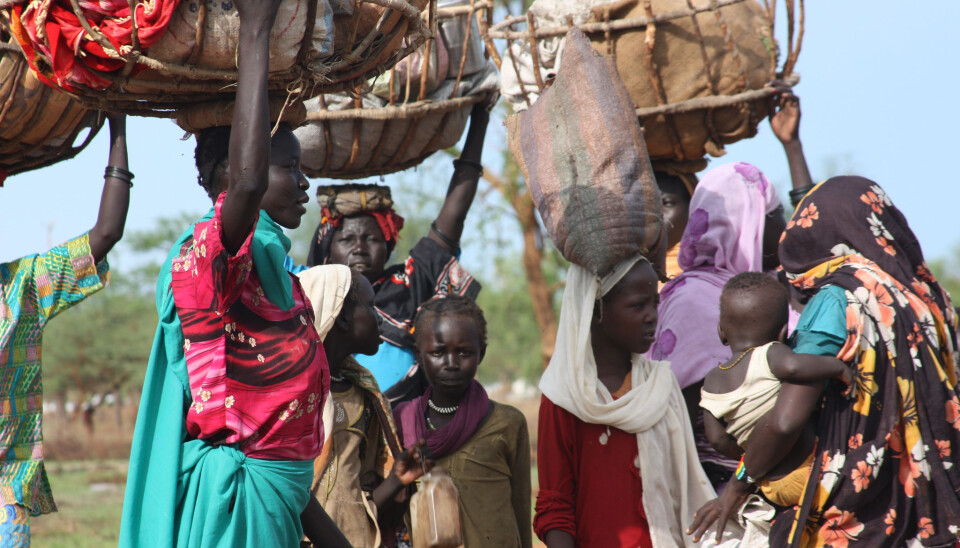An article from University of Oslo

Reproductive health causes tension in South Sudan
South Sudanese women find themselves in the middle of a tug-of-war between traditional and modern views on their reproductive health.
War unquestionably harms people's health and health infrastructures. In 2005, South Sudan ended the war after nearly five decades. But while building up their health infrastructure, conflicting ideas soon surfaced.
Even though international communities see the end of war as an opportunity for bold changes, evidence from South Sudan shows otherwise. The end of war here was rather a time where traditional views on women, as first and foremost child bearers, dominated and new ideas were sometimes difficult to accept.
Katerini Storeng and Jennifer Palmer have looked at public health policies and interventions which target unwanted pregnancy in contemporary South Sudan from 2005 when the war ended until 2015, with South Sudan returning to war again in 2013.
As many children as God gives
South Sudanese are encouraged to have families that are as large as possible, including “as many wives as a man can afford” and “as many children as God gives”. The fertility rate is high, at 7.1 live births per woman. Large families not only provide security from high child mortality and care for adults in old age, but also lend social status.
Through marriage and the exchange of bride wealth, women act as bridge-builders, building alliances with other families, clans and ethnic groups.
New wives are expected to become pregnant quickly - infertility suggests both economic and spiritual poverty. 45 percent of South Sudanese women are married by their 18th birthday and 28 percent have delivered a live birth at the same age.
Abstinence or nothing
Many factors frustrate the uptake of services for modern family planning, like contraception, and care for women after unsafe abortions. Custom and marriage traditions, which stand strong especially in the rural areas in South Sudan, promote women to bear many children. These customs are regulated only by periods of post-birth abstinence and breast feeding (breast feeding is documented to have a preventive effect against unintended pregnancy).
Child-spacing is common in practice, facilitated by the couple living apart temporarily and/or by men spending time with other wives.
During the war, the popular Sudan People's Liberation Army (SPLA), ideologically rejected family planning and abortion, and instead campaigned for military gain by entreating women to amplify reproduction to replace those lost to war.
Since the war, international donors and domestic technical officers within the Ministry of Health have been working to legitimize birth control via modern methods as a post-war nation-building project.
Reproductive surveillance
These competing discourses have given rise to a range of societal responses, including tensions between women, men, and health workers in healthcare institutions.
Discussions around the choice of contraceptive method are therefore based not only on clinical considerations but also, as several care providers explained to the researchers, on how well the method can be concealed.
Injections, intra-uterine devices and implants are sometimes preferred for this reason. Health workers must also be prepared for angry reactions from clients’ husbands if they have not been part of the decision to take up a method.
"But secrecy can itself incur risk, says Storeng. As one such provider described for them:
“In our culture, if a woman does something secretly, he can beat her. […] If the husband refuses and then the lady goes [to get contraception] it will bring big problems, even if she has 5 or 10 children, he will divorce. ”
Consequently, before providing contraception, many health workers seek to verify that a woman has her husband's consent, even going so far as to request men's phone numbers to confirm it. As one provider explained: “a midwife's first question is always, ‘have you talked to your husband?’”
In the absence of contraception, abortion is common
Constitutional law permits abortion to save a mother's life or in the case of fetal death. Although widely regarded as sinful, induced abortion occurs amongst all South Sudanese ethnic groups.
According to health providers, increasing numbers of women in the capital in Juba need post-abortion care after self-induction or after having received incomplete terminations in the private health sector.
Complications from unsafe abortions burden already stretched government hospital services. For example, in one tertiary facility, 45 percent of admissions to the gynecological unit over a seven year period were for post-abortion care, including miscarriages and induced terminations.
Although data is lacking, unsafe abortion undoubtedly contributes to South Sudan's extremely high maternal mortality.
The international community was well aware of the SPLA's stance against contraception. Consequently, many NGOs considered providing contraceptives a political and security risk. One NGO representative even feared that communities who rejected family planning might take-up arms against them and force programmes to close, compromising their wider maternal health and primary healthcare aims.
"No women's groups seemed to have developed arguments for or against family planning or abortion. As one representative said, “Women's groups might take up family planning one day, but I don't know …”, explains Palmer.
Like in other African countries, offering post-abortion care, rather than promoting legal change to enable safe abortion provision, was a politically acceptable way for both domestic and international policy actors to promote care without having to engage in the contentious issue of abortion rights.
Making husbands advocates
What Storeng and Palmer term ‘reproductive surveillance’ limits women's use of accessible family planning services and leads to violence when clandestine abortion is discovered.
Such confrontations limit women's options, but sometimes, transform men into unlikely advocates of family planning. Providers from several family planning organisations told stories about husbands who initially threatened them, but ended up becoming “very good friends” of the organisation and promoting their services to others after having the chance to discuss contraceptives in detail at the clinic.
Policy actors also identified politicians who have attended family planning workshops and come back “completely converted,” as one of them interviewed in the project put it.
The return to war
As war has returned to parts of South Sudan (2013-present), United Nations (UN) camps for internally displaced people have sprung up to house those displaced by the conflict. While medical interventions in the camps require less negotiation with the government, war continues to shape women's lives and tensions surrounding family planning have come to a head.
As one NGO representative explained, in the tense confines of camps, there was a need for post-abortion care - “a lot, by international standards”- both to deal with unsafe abortions and the collateral social effects.
This is because, here, women's use of NGO-sanctioned contraception and post-abortion care services is met by the surveillance and hostility of their neighbors. Particularly when the women’s husbands are away fighting. Where national, ethnic and reproductive ideologies are being violently negotiated, such reproductive health services are thus unintentionally inviting violence onto users.
International organisations have begun facilitating discussions with encamped communities about the potential need for abortion in relation to rape, but they have been publicly silent on the potential that pregnancy prevention or abortion may be associated with consensual sex.
Intra-communal reproductive surveillance in displaced person camps, which Storeng and Palmer understand as a form of reproductive control, has also been under-appreciated here and, potentially, globally.
































